Question and Answers – January 2013
Neil enjoys getting your questions here at e-gardens, but he does require that a photo accompany all questions we include in this visual medium. He chooses those questions of greatest general reader interest, and he answers them in the next edition of e-gardens. Click to send him your photo and question. Here are this month’s inquiries. (Note: we get many plant ID questions each month. Those are most commonly of interest only to the person sending them, so Neil usually does not include them.)
Question: This clover is in my Floratam St. Augustine, and it never seems to die out, even in the winter. What can I use to eliminate it without hurting the Floratam? R., Mission.
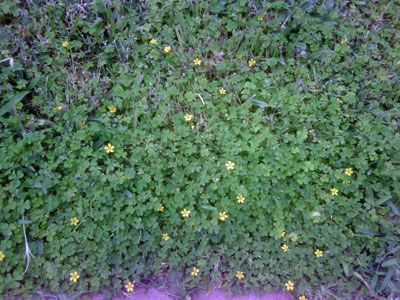
Answer: Floratam St. Augustine, for whatever the reason, does seem to be more sensitive to herbicides than most other cultivars of St. Augustine. The weed you have appears to be oxalis (some type of sheep sorrel), and it truly is perennial. Its seed capsules literally explode (similar to those of impatiens), throwing seed several feet away, so it ends up covering an area in a hurry. Check with your local independent retail garden center, and ask them to show you products containing only 2,4-D. Hi Yield and American Brand products, both packaged by VPG in Bonham, Texas, do have them. Check the fine print to see if Floratam is exempted. You could spot-treat with one of these on a test area, to see if you get satisfactory results. Oxalis is a bit tenacious, and its leaves are waxy. They tend to repel sprays, so apply the spray with fairly small droplets, to coat the leaves just to the point of drips forming. If necessary, include one drop of liquid dishwashing detergent per gallon of spray to help hold the herbicide on the leaves.
Question: We have just purchased 14 acres. It is hilly and rocky, and the dominant trees are cedars (junipers). The neighbor on one side has done some clearing, and has created an unattractive view from our fence line. I would like to plant something native, fast-growing, drought-tolerant and spreading to block the view. Suggestions? A.M., Burnet.
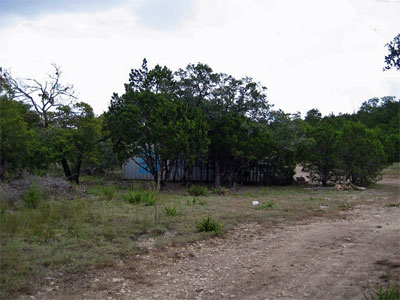
Answer: That’s sad. I’ll do what I can to help, but the limiting factors will be "fast-growing" and "drought-tolerant." Those terms are usually self-exclusive. In an effort to gain privacy on our 11 acres in rural Collin County, I used the native eastern redcedars, and I watered them religiously for the first couple of years to get them started. Honestly, junipers would also be my suggestion for you. Your native junipers would be the least obvious species you could use, since they’re already there. If you could figure a way to get water to them every 5 or 6 days until they really take off, that would speed things along. I would look for small transplants on your own property. You’ll get 15-foot junipers faster if you transplant 15-inch seedlings than you will if you opt for great big plants 6 or 8 or 12 feet tall. There is a high survivability rate for small plants, and a very low rate for big transplants. You may have a native plant nursery near you that would have them already growing in containers. Texas mountain laurel is certainly suited to the soils and climate, but it’s slow and expensive. Non-native plants just wouldn’t look right, but if you opted for them, elaeagnus and abelias are evergreen and drought-tolerant. Vitex isn’t evergreen, but it’s certainly handsome. I really hope this is of help. Good luck!
Question: I have a 25-year-old Choctaw pecan tree that had a lot of pecans on it this year. However, they did not fill out properly, and many tried to germinate while they were still on the tree. What went wrong? J.N., Denton County.

Answer: You may have encountered hickory shuckworms. They tunnel within the shucks of the pecans during August. That’s the time that water is being transported into the kernels to cause them to fill properly. With the interruption to the "pipeline," the kernels do not develop as they should. In fact, many of the pecans also fail to fall properly, not hitting the ground until January and February. You’ll want to spray with a labeled insecticide in early August, then repeat the treatment 15 days later. Malathion is the product that’s commonly used. It’s also quite likely that you had such a big crop of pecans that the tree just couldn’t push enough water into the kernels, even if shuckworms were not present. That’s a fault of many of the older, large-fruiting varieties such as Mahan and Mohawk. As for the sprouting within the pecans, that’s an oddity called vivipary. Some varieties are much more susceptible to it than others. As I recall, Burkett has a bad reputation for doing that. I do not get a lot of questions about the problem happening to Choctaws.
Question: I have a Shumard red oak that does not turn red in the fall. Its leaves just go to brown. Is this caused by a soil condition? A., no city given.
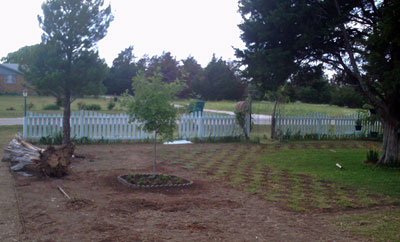
Answer: Not at all. Fall color varies greatly from one year to the next and from one Shumard red oak to the next. In any event, it’s not anything over which you have any control. I have several red oaks on our property, all with the very same growing conditions. Some give me great fall color, and several do not. But, for the other 50 weeks out of the year, they’re absolutely beautiful trees that I wouldn’t trade for any other species.
Question: We have four elaeagnus shrubs that the builder put in front of our house five years ago. Three have done very well, but this one is struggling. It got too tall, and I wanted it to be full from top to bottom, so I pruned it back in June. What would have caused it to turn brown in the one section? Should I just replant with another one? M.G., Forney.
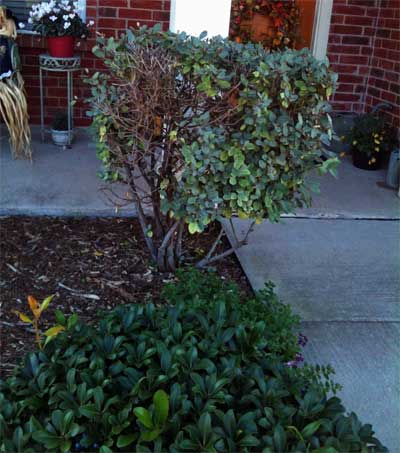
Answer: Let me begin my answer by saying that the mature size of an elaeagnus shrub would be 6 to 8 feet tall and 8 or 9 feet wide. I really don’t think you’ll ever be satisfied with that species in that location. Great plant, but wrong place. Pruning in June means that you cut off almost all of its new growth, and that’s a big setback for a plant that has just put all its spring burst of growth into producing those new shoots and leaves. I just think that the pruning and the placement worked against what would, in other circumstances, be a really dependable plant. I’d suggest having a nurseryman or landscape contractor work with you to develop a new planting plan for this area. Elaeagnus will continue to frustrate you there.
Question: My red oak tree has developed from a stump of a tree that died back due to sunscald. It looks very healthy, but its trunk is so short. Can I safely remove some of the lower branches and begin to shape it into tree form? D.B., no city given.
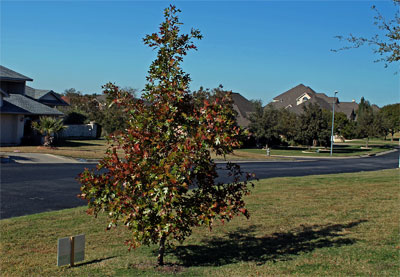
Answer: You can, and it’s time! If this were my tree, I’d use lopping shears to remove one branch at a time, beginning with the lowest one. Continue up the tree’s trunk, probably to 20 to 24 inches, until it has a more desirable look. Winter is a good time to do this, since you can easily see all the branches. Continue the pruning over the next couple of years, until the lowest limbs are at a more normal height (4 or 5 feet). Pruning like this is always a work-in-progress.
Question: I have some type of pest decimating my irises. The holes look like those of iris borers, but the white insects do not. I’m also seeing black ants. Will this problem affect any other unrelated plants? Any tips for control? A.D., College Station.
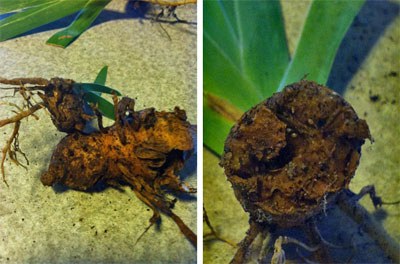
Answer: Your photos are very clear, and the one showing the entire rhizome looks like borer damage. I’m unsure about the white insects, but that’s probably just because I don’t raise as many irises as I do other perennials. Sometimes, secondary and tertiary insects show up within damage done by some other agent. Ants commonly get blamed when they’re found in decaying tree trunks, for example. I am not secure in my answer, however, and I will admit that. Perhaps someone else who has been down this same road will send us additional information. In the meantime, here is the "Iris Pests" page from the website of the American Iris Society. Good luck with it!

